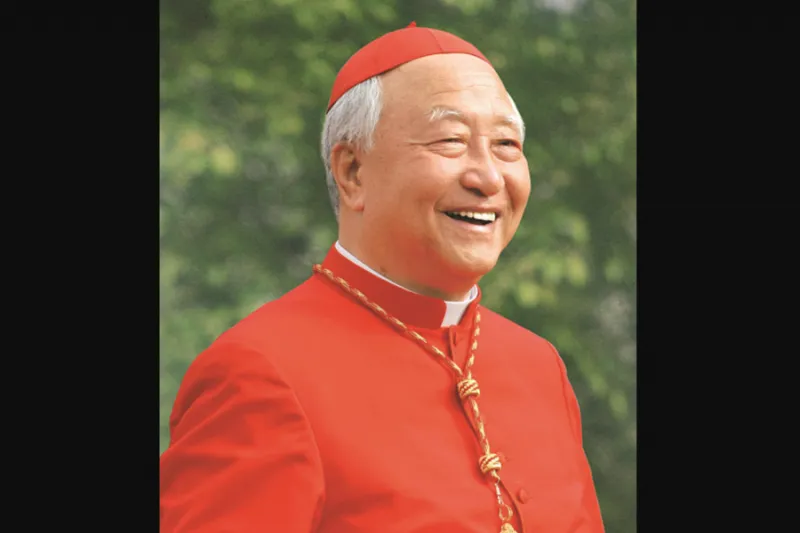
Vatican City, Apr 29, 2021 / 06:30 am (CNA).
Pope Francis offered his condolences Thursday after South Korean Cardinal Nicholas Cheong Jin-suk died at the age of 89.
The cardinal served as a bishop for more than 50 years in Korean dioceses, including 14 years as acting archbishop of Seoul and apostolic administrator of Pyongyang.
He is remembered for his passion for evangelization, pro-life advocacy, knowledge of canon law, service to the poor, and efforts to bring peace and unification to the Korean peninsula.
Cardinal Cheong died on the night of April 27 in St. Mary’s Hospital, where he had been receiving medical care since February. His body is being kept in a glass coffin in Seoul’s Myeongdong Cathedral until his funeral on May 1.
Cardinal Andrew Yeom Soo-jung, the current archbishop of Seoul, offered a midnight Requiem Mass in the cathedral on April 27. He remembered his predecessor as someone who “wanted the Church to be the light and salt of society, and practiced a pastoral ministry that emphasized the values of life and family.”
“Cardinal Cheong gave out everything he had to churches and the poor. He donated his organs to devote himself to helping the weak,” he said.
Cheong was born into a Catholic family in Seoul in 1931, at a time when Korea was under Japanese colonial rule. He was baptized four days after his birth, and the cardinal once said that his mother took him with her to daily Mass during his early childhood.
His father left the family after the liberation of Korea in 1945 to go to North Korea, where he went on to become a vice minister, according to the Korea Herald.
Cheong was admitted to Seoul National University, the top university in South Korea, to study chemical engineering in 1950, but his studies were interrupted by the start of the Korean War.
During the war, he served as an interpreter in the South Korean National Defense Corps. In the office of a U.S. Army chaplain, he found a book on St. Maria Goretti that helped inspire him to decide to become a priest.
After studying for the priesthood at Catholic University of Korea, he was ordained on March 18, 1961.
Cheong studied in Rome from 1968 to 1970, obtaining a degree in canon law from the Pontifical Urban University.
Upon his return to South Korea, he was consecrated bishop of Cheongju at the age of 39 and took the episcopal motto, “Omnibus Omnia,” meaning “All things to all people”.
He spent the next 28 years serving as bishop of Cheongju, where he helped to establish Kkottongnae, the largest Catholic charitable organization in South Korea.
Cheong led the years-long effort to translate the 1983 Code of Canon Law into the Korean language and published more than 50 books during his lifetime, including 15 commentaries on canon law.
He served as president of the Korean bishops’ conference from 1996 to 1999.
St. John Paul II appointed him archbishop of Seoul and apostolic administrator of Pyongyang in 1998. Pope Benedict XVI made him a cardinal in 2006.
From 1998 to 2004, the cardinal was president of the Korean bishops’ conferences Commission for the Reconciliation of the Korean People, which worked toward bringing about the peaceful unification of the Korean peninsula.
He then launched the Catholic Life Committee in 2005 and advocated for investment in adult stem cell research.
The cardinal retired as archbishop of Seoul in 2012 but continued to write and publish books.
Pope Francis sent a telegram to Cardinal Yeom expressing his condolences upon the death of Cardinal Cheong.
“United with you in thanksgiving for Cardinal Jin-suk’s many years of service to the Church in Korea and to the Holy See, I join all assembled for the solemn funeral Mass in commending his noble soul to the compassionate love of Christ the Good Shepherd,” the pope wrote.
“To all who mourn the late cardinal’s passing in the sure hope of the Resurrection I cordially impart my Apostolic Blessing as a pledge of consolation and peace in the Risen Lord.”
If you value the news and views Catholic World Report provides, please consider donating to support our efforts. Your contribution will help us continue to make CWR available to all readers worldwide for free, without a subscription. Thank you for your generosity!
Click here for more information on donating to CWR. Click here to sign up for our newsletter.




Leave a Reply